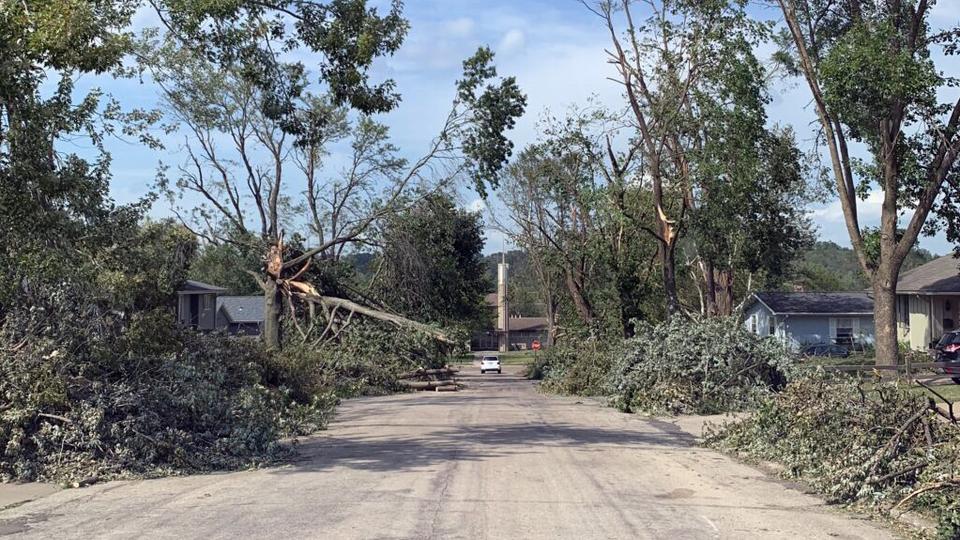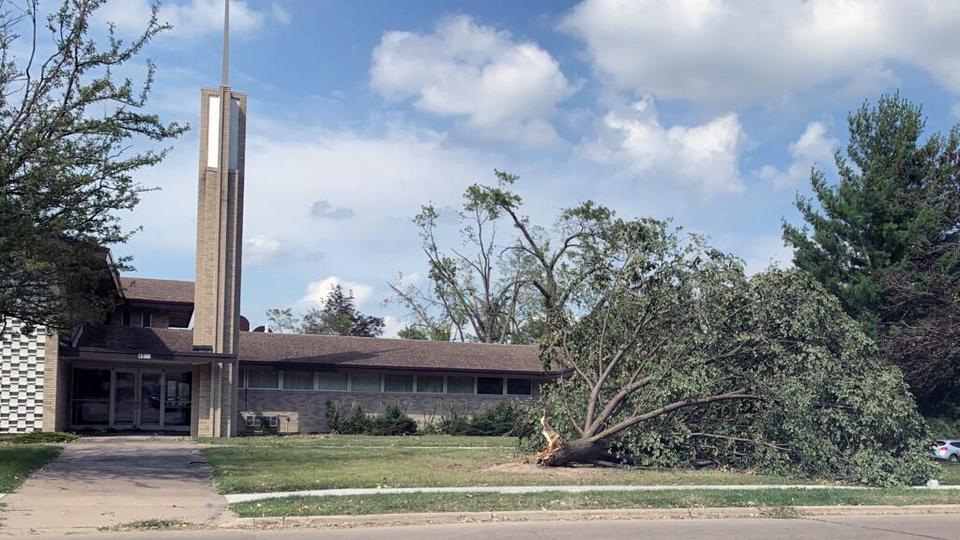
Iowa storms
Street leading to a Latter-day Saint meetinghouse in Cedar Rapids, Iowa, reveals the damaging power of August 10, 2020, storm. Photo by Josh Hansen, courtesy of Church News. All rights reserved.This story appears here courtesy of TheChurchNews.com. It is not for use by other media.
By Jason Swensen, Church News
Days after a disastrous storm felled pine trees all across his backyard, Cedar Rapids, Iowa, resident Nick D’Amico stepped out of his front door and unexpectedly made a few new friends.
“There were some gentlemen wearing yellow T-shirts working in my neighbor’s front yard,” said D’Amico. “I said, ‘Good morning’ and walked to my backyard — and one guy walked in behind me.”
Smiling, the man in the familiar yellow Helping Hands T-shirt explained to D’Amico that he and his other Latter-day Saint volunteers were helping clear uprooted trees and fallen branches from the neighbor’s yard.
“But when we finish,” the man told D’Amico, “we can help cut out the trees in your yard, if you want?”
“Absolutely,” replied D’Amico, who is not a Latter-day Saint.
That unsolicited, free-of-charge effort from the Helping Hands volunteers “was a really big help,” he added. “It was not just about the clean-up work — what they did also gave me some hope.”
Hope in Cedar Rapids and in communities across the Hawkeye State is a commodity perhaps as valued at the moment as chainsaws and reliable electrical service more than a week after a so-called “derecho” — a widespread, long-lasting powerful storm — hammered the region.
Winds of more than 100 mph were recorded August 10 as a line of severe storms rumbled through Iowa and other parts of the Midwest, leaving damaged homes, downed trees and more than a million without power for extended periods, CNN reported.
Counted among the many still feeling the effects of the storm — while simultaneously assuming prominent roles in the ongoing relief effort — are many Latter-day Saints.
“Our hearts are full, but our bodies are a bit on empty,” Cedar Rapids Iowa Stake President Joseph Miller told the Church News. “But we’ve had a great response from members who immediately came out to serve and help our community.”
Cooperation between the Church and government and other local non-profit partners has helped brighten spirits at an otherwise dark period, he added.
“We’ve had a lot of help coming into town from other stakes in the area and from state and federal government resources. We’re feeling grateful. It’s been quite a ride, but we feel like the Lord’s hand has been involved and has lifted us and given us the strength we’ve needed.”
Still, he added, the consequences of the storms remain a painful reality for many in the Cedar Rapids stake and beyond.

Iowa storms
A street leading to a Latter-day Saint meetinghouse in Cedar Rapids, Iowa, reveals the damaging power of a storm on August 10, 2020. Photo by of Josh Hansen, courtesy of Church News.All rights reserved.
“The power is still out for some of our members, and large trees have fallen on their homes and other properties, oftentimes blocking their abilities to get in and out. Yards and streets are still full of tree trunks and large limbs.
“There is still much to do.”
Fortunately, no members of the Cedar Rapids stake appear to have been permanently displaced from their homes, added President Miller.
In the moments following the storm, Latter-day Saints began checking on fellow members and neighbors and reporting back to their local Relief Society and priesthood leaders. When cellphone communication was unavailable, “the members went out and visually checked on their ministering families to make sure they were all OK.”
There’s no ideal time for a destructive storm to hit — but the recent Midwest derecho, of course, struck during the ongoing pandemic. Many people already anxious and exhausted because of COVID-19 fears were forced to battle a new, unexpected adversary. School openings have been delayed and jobs have been impacted.
“It’s just added more uncertainty at an already uncertain time for our families,” said President Miller.
Helping Hands volunteers, including teams of full-time missionaries, have been quick to answer calls to action. Three-hundred “Helping Handers” were working in heavily-damaged areas on the first weekend following the storm.
An additional Helping Hands effort is expected this weekend (August 22-23) in the greater-Cedar Rapids area “to help the community get over the recovery hump and make sure all of our critical needs have been met.”
Members of the local Amish community are expected to join the Helping Hand clean-up efforts.
A key element of that response includes Church-sponsored food deliveries to help relieve shortages being experienced by some in the aftermath of the disaster and the ongoing pandemic.
“During the first couple days following the storm we spent a lot of time just clearing debris and helping people dig themselves out,” said Bowman Ward Bishop Jacob Christenson. “But now, more and more people are struggling with food insecurity because their food spoiled because the power was out for so long.”
Meanwhile, an older meetinghouse in the Cedar Rapids stake suffered some damage, but nothing that can’t be repaired fairly easily. Meanwhile, the Cedar Rapids stake center is being utilized as a command/distribution center.
The Iowa Latter-day Saints remain eager to help lift the spirits of their fellow members and neighbors.
“In addition to monitoring temporal affairs, we’re also closely trying to monitor the spiritual, mental and emotional conditions of the members of the Church here and do all we can to be proactive in our communities and bless the lives of those not of our faith.”
Copyright 2020 Deseret News Publishing Company